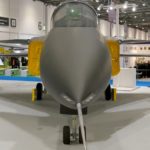FINN editor-in-chief Alan Peaford caught up with Team Tempest’s Programme Director on the first anniversary of the launch of future combat aircraft
The Team Tempest project is gathering pace with two new countries joining the project team, a 1,000-strong team and 500 companies involved across the entire supply chain.
Team Tempest Programme Director, Group Captain Jez Holmes, said there had been a “huge amount of progress” made from the programme’s launch at Farnborough Airshow in 2018, in terms of generating knowledge, understanding and skills. Headcount on the project team has increased by a massive 400 per cent in just one year – from 200 people at the project’s launch to around 1,000 now.
An uncertain world, with uncertain threats
The stealth fighter is being developed for the RAF by a consortium of the UK Ministry of Defence, BAE Systems, Rolls-Royce, Leonardo and MDBA. Italy and Sweden have both joined the project since the launch announcement.
Tempest is set to enter service in 2035, replacing the Eurofighter Typhoon. Group Captain Holmes said having an aircraft that was both adaptable and flexible was required to combat threats in an uncertain world.
When asked how you would effectively plan for an aircraft which was likely to be combating the threats of the future in 2080, Holmes said: “Well the answer is that you can’t really, you can make some assumptions, and our assumption is that its going to be uncertain world with uncertain threats. So one of the most important aspects of Tempest will be the ability to modify upgrade and update the whole capability as fast as we can.”
Holmes said work with Team Tempest’s international partners, Italy and Sweden was still in the early stages, but developing these relationships to understand both partners’ needs and strengths would be key.
Consortium approach
Industrial partnerships were also key to the consortium-based project. Group Captain Holmes explained: “The most critical aspect to Tempest is the synergistic nature of the programme, so we are working absolutely hand in glove with the four key primes who are also investing heavily in the programme.”
“Apart from that we have already engaged with 500 companies across the country, 140 contracts running, so this is going across the entire supply chain and across the country.”
As exciting as Google or Apple
As well as engaging with countries and industrial partners, Group Captain Holmes said engaging with future workers and enthusing them about the project was also an important aspect of the Programme Director role.
“I think that some of the people who will get involved in the design of this capability or building or even flying it are, quite frankly, still at school,” he said. “We have to engage with these young kids, really clever, exciting children who might want to come and join our sector.”
“Telling our story to them and making it as exciting as some other areas such as Google or Apple is an important aspect, so we are working with primary schools, we are working secondary schools and we’ve engaged with academia.”

